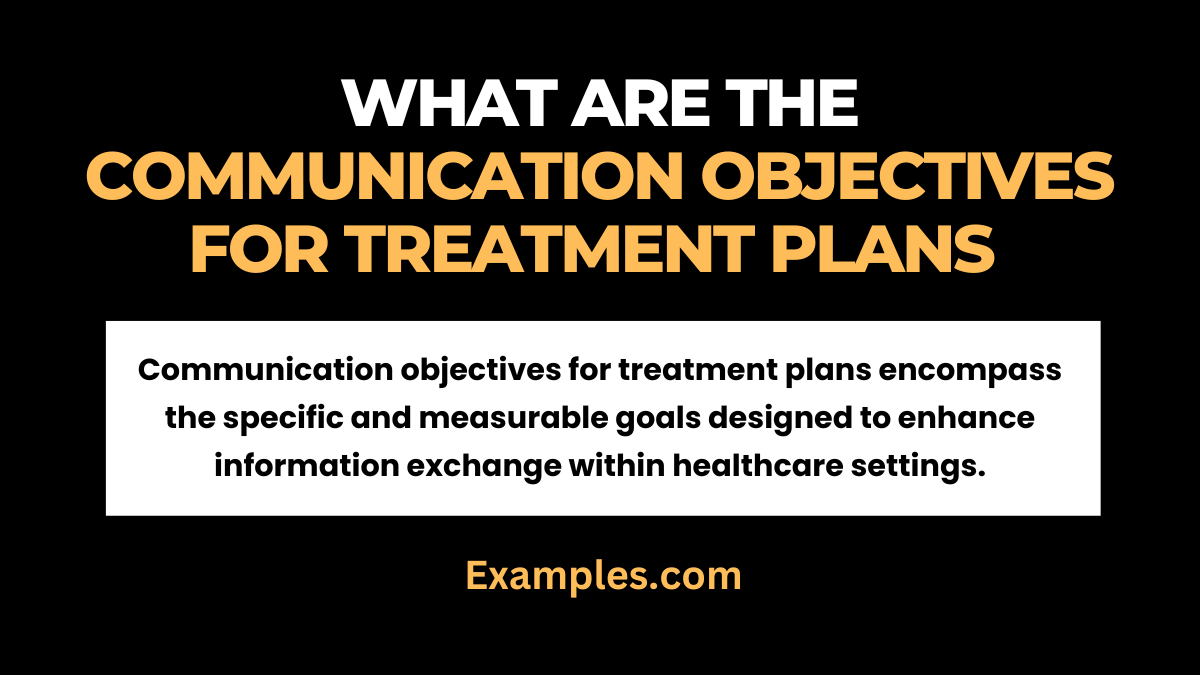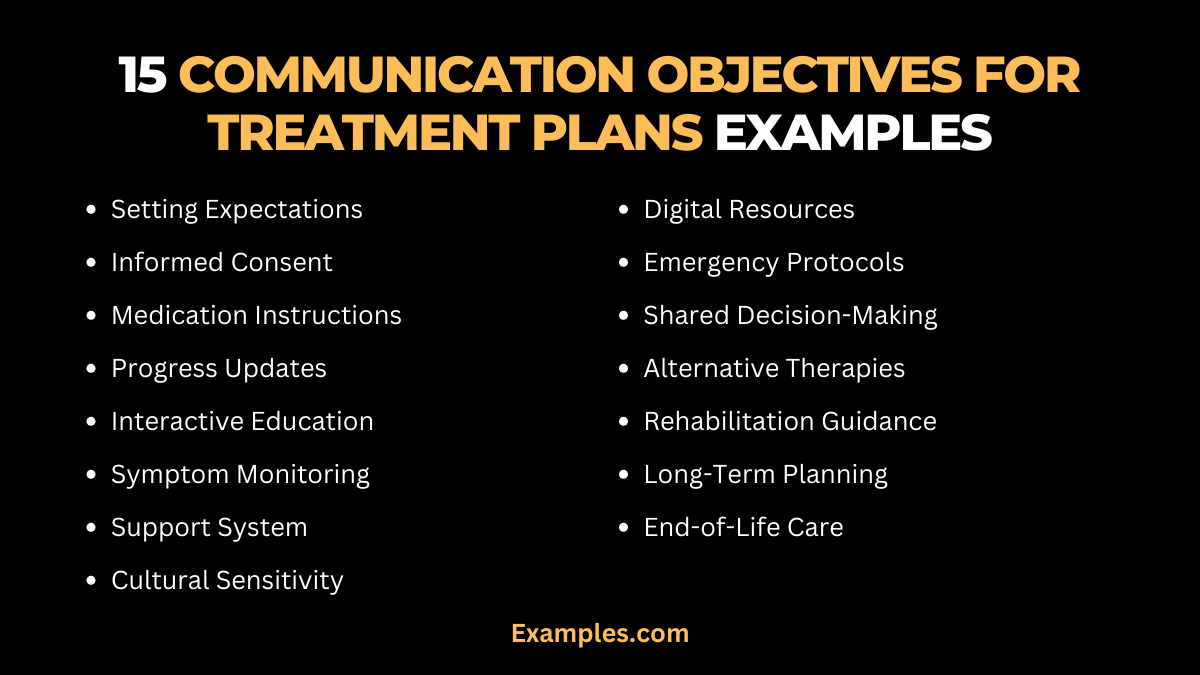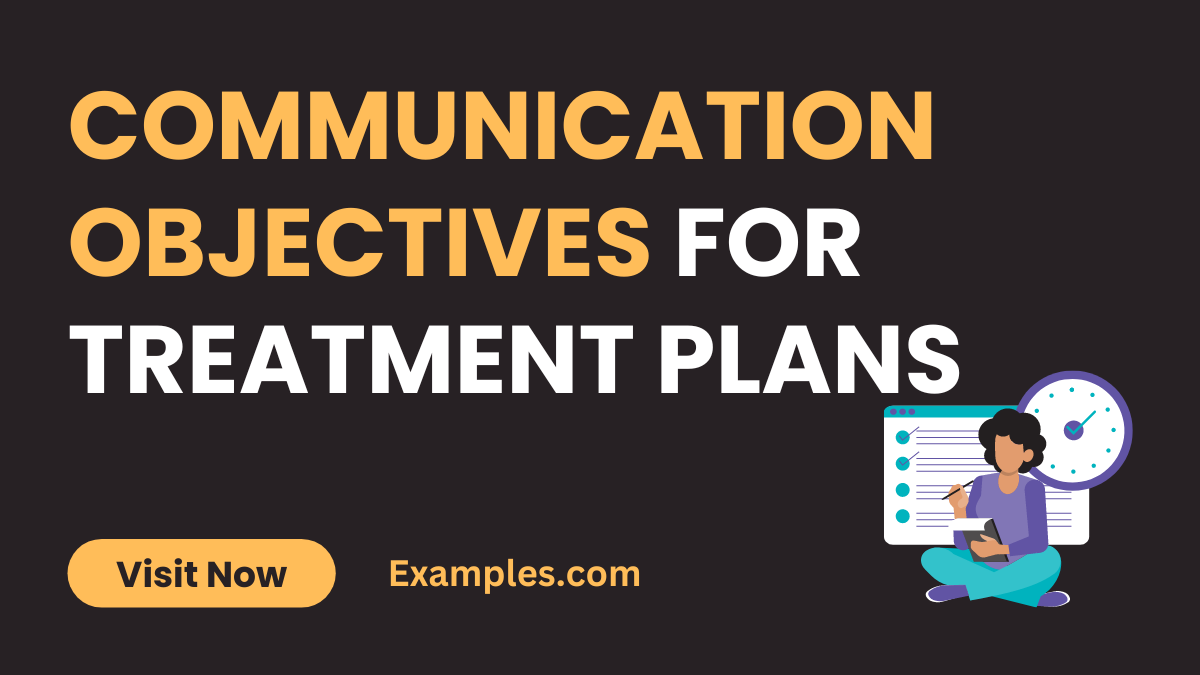14+ Communication Objectives for Treatment Plan Examples
Embark on a comprehensive journey with our guide on Communication Objectives for Treatment Plans. This complete resource unveils the key strategies and communication examples essential for crafting effective treatment plans. Discover how clear, targeted communication plays a pivotal role in optimizing health outcomes. Dive into practical insights, expert tips, and real-life examples to empower your approach in developing and implementing successful treatment plans.
What are the Communication Objectives for Treatment Plans

Communication objectives for treatment plans encompass the specific and measurable goals designed to enhance information exchange within healthcare settings. These objectives focus on ensuring clarity, understanding, and collaboration among healthcare professionals, patients, and other stakeholders. Effective communication is vital for successful treatment plan execution, promoting shared decision-making, adherence, and overall positive health outcomes.
15 Communication Objectives for Treatment Plans Examples
Effective communication in treatment plans involves conveying vital health information with precision and empathy. Clear objectives ensure seamless collaboration between healthcare providers and patients, fostering understanding and adherence to treatment regimens.

- Setting Expectations: Clearly explain treatment goals, potential side effects, and expected outcomes.
- Informed Consent: Ensure patients comprehend and consent to proposed treatments before initiation.
- Medication Instructions: Provide step-by-step guidance on medication usage, emphasizing dosage and timing.
- Progress Updates: Regularly inform patients about treatment progress, addressing any concerns.
- Interactive Education: Utilize visual aids and interactive tools for better comprehension of complex treatment information.
- Symptom Monitoring: Guide patients on tracking and reporting symptoms for timely intervention.
- Support System: Encourage patients to involve family or support networks in treatment discussions.
- Cultural Sensitivity: Adapt communication to align with patients’ cultural backgrounds and beliefs.
- Digital Resources: Offer online resources for additional information and support.
- Emergency Protocols: Clearly communicate actions to take in case of treatment-related emergencies.
- Shared Decision-Making: Involve patients in decision-making processes, respecting their preferences.
- Alternative Therapies: Discuss and consider alternative treatment options, addressing patient preferences.
- Rehabilitation Guidance: Provide comprehensive guidance on rehabilitation exercises and routines.
- Long-Term Planning: Discuss long-term treatment plans, emphasizing sustainability and lifestyle adjustments.
- End-of-Life Care: Communicate compassionately about end-of-life treatment options and palliative care.
Communication Objectives for Treatment Plans in Therapy
In therapeutic settings, clear communication objectives guide mental health professionals and clients towards shared goals. These objectives foster a trusting and supportive environment, crucial for effective therapeutic interventions and positive outcomes.
- Establishing Trust: Encourage open dialogue to build trust and rapport between therapist and client.
- Goal Setting: Collaboratively set achievable therapeutic goals for personal growth and well-being.
- Feedback Sessions: Provide structured sessions for clients to express thoughts and feelings about therapy progress.
- Crisis Communication: Develop strategies for effective communication during crisis or urgent situations.
- Self-Reflection: Encourage clients to articulate personal insights gained during therapy sessions.
- Empathy Enhancement: Promote empathetic communication to enhance understanding of clients’ experiences.
- Coping Strategies: Communicate and teach practical coping mechanisms to manage stress and challenges.
- Homework Assignments: Assign reflective exercises or tasks to reinforce therapeutic concepts outside sessions.
- Communication Assessment: Regularly evaluate communication dynamics to address potential challenges proactively.
- Termination Planning: Facilitate discussions about the conclusion of therapy, ensuring a smooth transition for clients.
Communication Objectives for Treatment Plans in Health Care
In healthcare, communication objectives are paramount for effective patient care, ensuring clear understanding, collaboration, and adherence to treatment plans. These objectives encompass various facets, from provider-patient interactions to interprofessional communication within healthcare teams.
- Informed Consent: Clearly communicate treatment details, risks, and benefits to ensure informed patient consent.
- Care Coordination: Facilitate seamless communication among healthcare providers to enhance overall patient care.
- Health Literacy Promotion: Use clear and accessible language to improve patient understanding of medical information.
- Follow-Up Protocols: Establish communication plans for post-treatment follow-ups and ongoing care.
- Family Involvement: Communicate with family members to create a supportive network for the patient.
- Treatment Adherence Talks: Address potential barriers and engage in discussions to enhance patient adherence to treatment.
- Symptom Reporting: Educate patients on effective symptom reporting, enabling timely intervention.
- Telehealth Communication: Develop strategies for clear and effective communication in virtual healthcare settings.
- Cultural Competence: Foster culturally sensitive communication to address diverse patient needs.
- Emergency Communication: Establish protocols for swift and effective communication during medical emergencies.
What are the Smart Goals for Treatment Plans
Setting SMART goals (Specific, Measurable, Achievable, Relevant, and Time-bound) is crucial in treatment plans to enhance their effectiveness and measure progress. Whether in therapy or healthcare, these goals provide a structured framework for individuals and healthcare professionals. Here’s a comprehensive guide on formulating SMART goals for treatment plans:
1. Specific (S):
- Define clear and precise objectives tailored to the individual’s needs.
- Example: “The patient will improve coping skills to manage anxiety-related symptoms.”
2. Measurable (M):
- Establish concrete criteria for measuring progress and success.
- Example: “Decrease depressive symptoms by 20% based on standardized assessment scores.”
3. Achievable (A):
- Ensure goals are realistic and attainable within the given context.
- Example: “Attend weekly therapy sessions for consistent progress.”
4. Relevant (R):
- Align goals with the overall treatment plan and the individual’s broader well-being.
- Example: “Enhance communication skills to strengthen interpersonal relationships.”
5. Time-bound (T):
- Set a specific timeframe for achieving each goal, fostering a sense of urgency.
- Example: “Improve sleep hygiene within four weeks, aiming for at least seven hours of quality sleep per night.”
In conclusion, establishing effective communication objectives for treatment plans is paramount for successful outcomes. By employing SMART goals—Specific, Measurable, Achievable, Relevant, and Time-bound—individuals and healthcare professionals create a structured path towards improvement. This complete guide ensures a comprehensive understanding, empowering individuals to set meaningful objectives and enhancing the overall efficacy of treatment plans.



